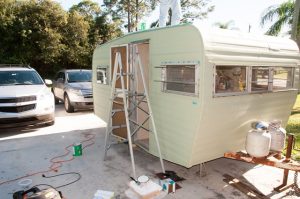Camper Roof Yourself
Although extensive RV roof damage may require a professional repair, most leaks, rips and holes can be easily repaired. First, clean the damaged area and dry it thoroughly. Then, choose the right type of patch and caulking. Some RVs have aluminum or metal roofs, which need to be resealed. Choose a special sealant that’s designed for this material.
Ethylene propylene diene monomer, or EPDM rubber, is a common material for Barrie Roofing. You may recognize it as the black sheets that cover office buildings, and it’s a good choice for an RV roof because it doesn’t dent easily. If you have a fiberglass RV or trailer, it’s worth treating with a high-quality automotive wax annually to prevent oxidation. You can also use a rubbing compound that’s made specifically for fiberglass.

You can find out what your RV’s roof is made of by removing the vent trim ring (if possible) and looking at the roof material underneath. Then, you can tell whether you have a TPO or EPDM roof. If the roof is one color, front and back, it’s probably TPO; if it has a smooth or fleece backing, it’s likely EPDM. You can also check by doing a pinch test on the surface. If it feels powdery, that’s a sign that it’s time for a recoating.
How to Repair a Camper Roof Yourself
When the time comes to make repairs, it’s important to have all the right tools on hand. This includes a ladder to get up on the roof. A general sweep of the RV roof should be done first to look for any soft spots. These are often caused by water damage and can lead to leaks or worse, structural problems. Once the area is cleaned, a product such as Eternabond seam tape can be used to help prevent future leaks on metal roofs. This is a tough self-sealing product that works like duct tape, but is made for RV roofs. Dave recommends keeping a roll of this on hand in case an emergency repair is needed.
In addition to the Eternabond, a kit that includes a peel and stick EPDM patch as well as a tube of self-leveling lap sealant is also helpful. This type of patch is easy to install and a good option for repairing a small hole or tear in fiberglass roofs. As with any building project, the caulking needed for RV roof repair is a key part of the process. Caulking helps to seal cracks and prevent leaks on your camper roof, especially around air conditioning units, roof vents and skylights. Make sure the caulking you choose is compatible with your RV’s roof material, such as using silicone on EPDM rubber or a water-resistant lap sealant for fiberglass.
A tube of self-leveling lap sealant is an ideal product to use to reseal gaps and replace old caulking. You will need a caulking gun to apply the lap sealant, but it is easier to use than silicon caulking commonly found in hardware stores and dries quickly, so you’ll be done faster. You will also need a fiberglass repair kit to repair punctures in your fiberglass roof. Before applying the repair materials, you’ll need to clean and prepare the area by following the kit instructions. You may also need a ladder and safety equipment, depending on the height of your RV.
A sealant or RV roof coating is used to fill in cracks and prevent water from penetrating. After cleaning the area thoroughly, the product can be applied according to the instructions. This will help keep the roof waterproof and extend its life. There are several products available that can be used to repair a camper roof, depending on the type of roof it has. For example, Eternabond makes a tough self-sealing tape that you can use to patch holes in an RV’s roof. It comes with its own primer and adheres to the roof easily.
Name : Barrie Roofing & Repair Contractors
Address: 279 Yonge St, Barrie, ON, L4N 7T9 P.O Box#23013
Phone: 705-999-7628